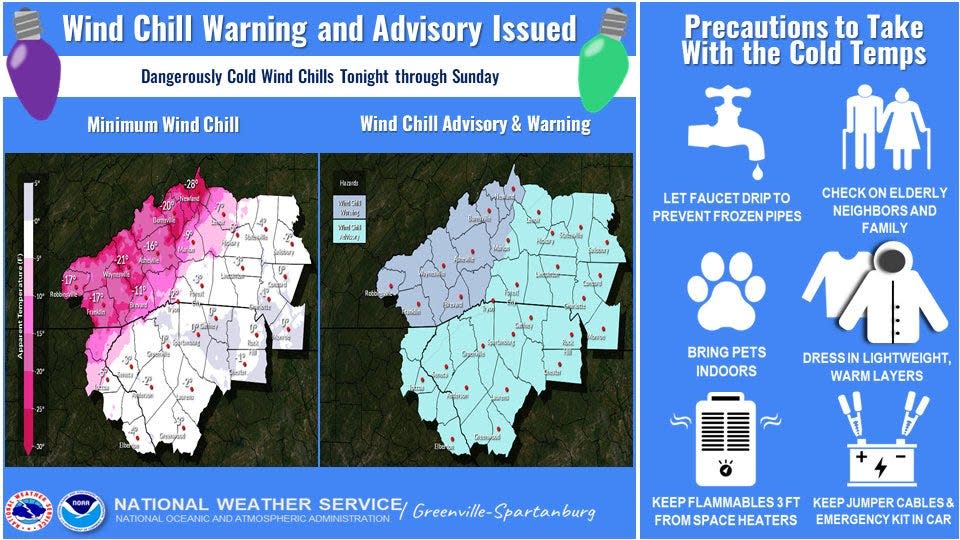Check on people, pets, pipes: Upstate SC braces for arctic front. What you need to know.
Greenville, Spartanburg, and Anderson area residents should be prepared for one of the coldest Christmases in recent memory.
Clay Chaney, a meteorologist with the National Weather Service, says Upstate residents should prepare for over 48 hours of weather below freezing temperatures, starting on Friday morning and lasting through most of Christmas Day.
Both Chaney and Robbie Swofford, Emergency Management Coordinator for Spartanburg County, reiterated the need to stay indoors, dress in layers, check in on friends and family and bring animals inside.
Live updatesWinter storm whips up blizzard conditions, plunging temperatures across US
How cold will it get in the Upstate Christmas weekend?
Between Friday night and Saturday morning, the Upstate could see wind chills as low as 5 below zero with wind gusts as high as 22 mph. There is a chance for a wintry mix in parts of the Upstate Friday morning. The forecasted low for Friday night is 12 degrees.
"Starting pretty early Friday morning, temperatures are pretty much going to drop like a rock," Chaney said. "We'll probably see a high temperature between midnight and 3 a.m., and then a blast of cold air will come in right after that."
Wind chills may be as low as 20 degrees below zero in the North Carolina mountains. If you're traveling, be sure to have jumper cables and an emergency kit in your vehicle.
Here are the top 10 lowest max temperatures for our climate sites on Christmas day. If the current forecast verifies, this will rank near the top 7 all-time coldest Christmas max temperature since records began. #scwx #ncwx pic.twitter.com/R1S4q2zuFX
— NWS GSP (@NWSGSP) December 21, 2022
The forecasted low Christmas Eve night is 16 with highs in the low 30s during the day. There is a slight warm-up on Christmas Day with sunny skies, highs in the mid-30s with lows still in the teens.
Chaney said northern Spartanburg County and higher elevations across the Upstate may see temperatures drop to single digits, however, he did not expect snow as precipitation will likely not overlap with the sub-freezing temps.
High temperatures will be around 40 degrees Monday, Dec. 26.
States including Wyoming, Colorado, and Montana have already recorded dramatic temperature plunges and more than a dozen others had temperatures below zero Thursday morning as a blast of Arctic air advances over much of the U.S. and a blizzard brews in the north.
More than half of U.S. states were forecast to see some areas with minimum wind chill temperatures in the negative double digits in coming days, and the coldest regions were bracing for wind chills below minus 50 degrees, according to the National Weather Service. There will be "dangerously cold conditions across most of the country this week," the weather service said.
High winds combined with moderate amounts of snow could cause blizzard conditions in parts of the Midwest, Great Lakes, and Northeast.
Forecasters warn the weather could snarl busy holiday travel and knock out power.
Flight canceled? What you need to knowOver 1,200 US flights canceled as winter storm hits the nation with snow, high winds
While limiting time outdoors and dressing with extra layers are obvious first steps, here's a few others things to be mindful of:
Protect your pipes
Pipes are at the greatest risk and most commonly freeze at or below 20 degrees, although pipes can freeze at any point at or below 32 degrees, the freezing temperature of water.
Foam pipe insulation can be purchased at most hardware stores and can prevent pipes from freezing. Insulating your pipes is more effective in avoiding freezing than simply rags or towels.
Turning off the water supply that feeds to the outside spigot and draining the excess water are good steps to take before we reach sub-freezing overnight temperatures.
Removing garden hoses is also advisable.
In order to keep your pipes from freezing, the Red Cross suggests letting water drip from the faucet served by exposed pipes.
If your pipes do freeze and you can locate the frozen area(s), use an electric hair dryer, or wrap the pipe with an electric heating pad or towels. Be careful of flammable areas and do not use any open flame device such as a blowtorch, kerosene/propane heater, or charcoal stove.
If you discover any broken pipes, turn off the main water supply to the house.
If you are not sure of what you are doing or discover any serious issues, call a licensed plumber.

Keep living things warm and indoors
Swofford said to check on elderly family members and relatives who live alone.
Bring pets indoors and plants that may succumb to the cold.
Swofford added that making sure alternative heating sources, like space heaters, are functioning and viable beforehand in the case of a power outage is important. If you're using a space heater, be sure to keep flammable items at least three feet away.
In case of a power outage
Ryan Mosier, a spokesman for Duke Energy, said the following are ways to report power outages:
Visit duke-energy.com on a desktop computer or mobile device.
Use the Duke Energy mobile app – Download the Duke Energy App from a smartphone via Apple Store or Google Play.
Text OUT to 57801 (standard text and data charges may apply).
Call the automated outage-reporting system, at: 800.POWERON (800.769.3766).
Visit the interactive outage map to find up-to-date information on power outages, including the total number of outages systemwide and estimated times of restoration.
Mosier emphasized that residents should avoid downed or sagging power lines and to keep nonperishable supplies handy in case of an emergency.
Chalmers Rogland covers breaking news and public safety. Reach him via email at crogland@shj.com.
This article originally appeared on Greenville News: Upstate SC braces for arctic front. What you need to know to stay safe

